
A surface-to-air missile (SAM), also known as a ground-to-air missile (GTAM) or surface-to-air guided weapon (SAGW), is a missile designed to be launched from the ground to destroy aircraft or other missiles. It is one type of anti-aircraft system; in modern armed forces, missiles have replaced most other forms of dedicated anti-aircraft weapons, with anti-aircraft guns pushed into specialized roles.
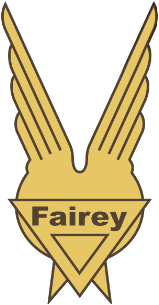
The Fairey Aviation Company Limited was a British aircraft manufacturer of the first half of the 20th century based in Hayes in Middlesex and Heaton Chapel and RAF Ringway in Lancashire. Notable for the design of a number of important military aircraft, including the Fairey III family, the Swordfish, Firefly, and Gannet, it had a strong presence in the supply of naval aircraft, and also built bombers for the RAF.

The Bristol Bloodhound is a British ramjet powered surface-to-air missile developed during the 1950s. It served as the UK's main air defence weapon into the 1990s and was in large-scale service with the Royal Air Force (RAF) and the forces of four other countries.

Seaslug was a first-generation surface-to-air missile designed by Armstrong Whitworth for use by the Royal Navy. Tracing its history as far back as 1943's LOPGAP design, it came into operational service in 1961 and was still in use at the time of the Falklands War in 1982.

Fireflash was the United Kingdom's first air-to-air guided missile to see service with the Royal Air Force. Constructed by Fairey Aviation, the missile utilised radar beam riding guidance. Fireflash had relatively limited performance and required the launching aircraft to approach the target from a limited angle astern.

The Fairchild SM-73 was a sub-sonic, jet-powered, ground-launched decoy cruise missile.

The English Electric Thunderbird was a British surface-to-air missile produced for the British Army. Thunderbird was primarily intended to attack higher altitude targets at ranges up to approximately 30 miles (48 km), providing wide-area air defence for the Army in the field. AA guns were still used for lower altitude threats. Thunderbird entered service in 1959 and underwent a major mid-life upgrade to Thunderbird 2 in 1966, before being slowly phased out by 1977. Ex-Army Thunderbirds were also operated by the Royal Saudi Air Force after 1967.

The Fairey Delta 1 (FD1) was a research aircraft developed and produced by British aircraft manufacturer Fairey Aviation. It holds the distinction of being the first British-designed aircraft to be furnished with a delta wing.
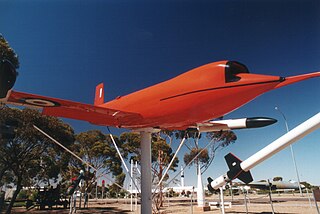
The GAF Jindivik is a radio-controlled target drone produced by the Australian Government Aircraft Factories (GAF). The name is from an Aboriginal Australian word meaning "the hunted one". Two manually-controlled prototypes, were built as the GAF Pika as a proof of concept to test the aerodynamics, engine and radio control systems, serialled A92-1/2, 'B-1/2'. The radio-controlled Jindivik was initially designated the Project B and received serials in the A93 series. Pika is an Aboriginal Australian word meaning flier.

The LBD-1 Gargoyle was an American air-to-surface missile developed during World War II by McDonnell Aircraft for the United States Navy. One of the precursors of modern anti-ship missiles, it was extensively used as a test vehicle during the late 1940s.
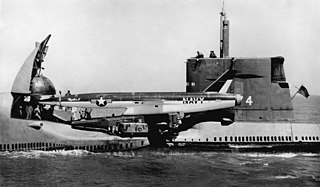
The SSM-N-9 Regulus II cruise missile is a supersonic guided missile armed with a nuclear warhead, intended for launching from surface ships and submarines of the U.S. Navy (USN).
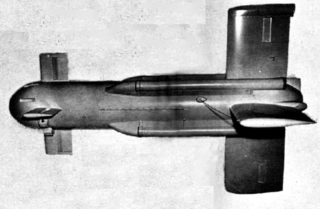
The Little Joe, also known by the United States Navy designation KAN, was an early American ship-based, short-range surface-to-air missile, the development of which was initiated in 1945 as a response to the Kamikaze tactics used by the Japanese. Although the missile was successfully tested, the end of World War II removed the requirement for the missile, and the project was abandoned in 1946.

The Creative Research On Weapons or Crow program was an experimental missile project developed by the United States Navy's Naval Air Missile Test Center during the late 1950s. Intended to evaluate the solid-fueled integral rocket/ramjet (SFIRR) method of propulsion as well as solid-fueled ramjet engines, flight tests were conducted during the early 1960s with mixed success.

The AAM-A-1 Firebird was an early American air-to-air missile, developed by the Ryan Aeronautical Company. The first air-to-air missile program developed for the United States Air Force, the Firebird was extensively tested in the late 1940s; although it proved successful in testing, it was soon obsolete due to the rapid advances in aircraft and missile technology at the time and did not enter production.
Brakemine was an early surface-to-air missile (SAM) development project carried out in the United Kingdom during World War II. Brakemine used a beam riding guidance system developed at A.C. Cossor, while REME designed the testbed airframes. Trial launches were carried out between 1944 and 1945, and the effort wound down as the war ended. Although Brakemine would never be used in its original form, its use of the "twist-and-steer" guidance method would later be used on the more capable LOPGAP design, which, after major changes, emerged as the Bristol Bloodhound. A single Brakemine survives in the REME Museum.

The AAM-N-5 Meteor was an early American air-to-air missile, developed by the Massachusetts Institute of Technology and Bell Aircraft for the United States Navy. Designed for launch from carrier-based aircraft, the program proceeded to the flight testing stage before being cancelled.

The Radioplane XKD4R, known by the company designation RP-70, was an American target drone developed by the Radioplane Division of the Northrop Corporation. Although it was not produced in quantity, it was developed into the successful AQM-38.
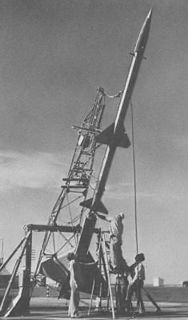
Boeing's Ground-to-Air Pilotless Aircraft (GAPA) was a short-range anti-aircraft missile (SAM) developed in the late 1940s by the US Army Air Force, and then the US Air Force after 1948. It was given the reference number SAM-A-1, the first Surface-to-Air Missile (SAM) in the 1947 tri-service designation system. By 1950 over 100 test rockets had been launched using a variety of configurations and power plants, with one launch in 1949 setting the altitude record for a ramjet powered vehicle at 59,000 ft (18,000 m).

The CTV-N-2 Gorgon IIC – also designated KGN, KUN, and CTV-2 – was an experimental drone, originally intended as a surface-to-surface missile, developed by the United States Navy near the end of World War II. It was used to test control and homing systems for guided missiles, and was also produced in small numbers as a target drone under the designations TD3N and KD2N.
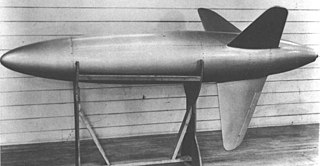
The JB-3 Tiamat, also designated MX-570, was an early air-to-air missile developed by Hughes Aircraft for the United States Army Air Forces during World War II. Regarded as a purely experimental vehicle, test launches took place for several years before the program was terminated.




















